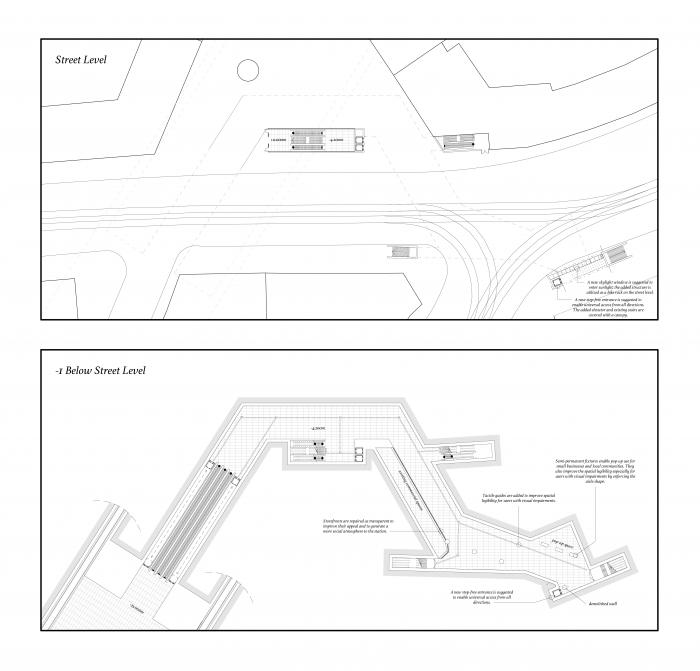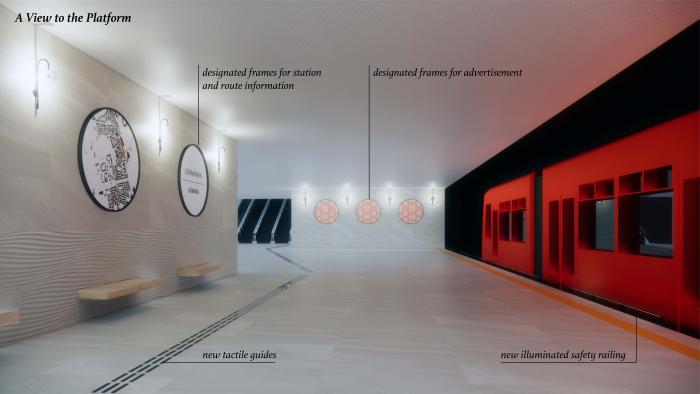I. SUMMARY INFORMATION
Project
268853
Status
Submitted
Award category
Regenerated urban and rural spaces
You want to submit
NEW EUROPEAN BAUHAUS RISING STARS : concepts or ideas submitted by young talents (aged 30 or less)
Project title
Helsinki <3 Metro
Full concept/idea title
A Research-Based Alternative for Retrofit Design of Sörnäinen Metro Station
Description
This design study suggests a research-based approach to the repair of metro stations. A conceptual retrofit design for the Sörnäinen station was compiled to visualize the application of wayfinding, universal design, and pedestrian traffic flow optimization. The concept promotes the renovation of existing metro systems to improve equitability, performance, and appeal of public transportation and, consequently, to mitigate emissions of both mobility and construction of new infrastructure.
Where is your concept/idea being developed or intended to be implemented in the EU?
Finland
Capital Region
Helsinginkatu 1
Helsinki
00530
II. DESCRIPTION OF THE PROJECT
Please provide a summary of your concept/ idea
This case study of Sörnäinen station examined the preconditions of improving qualitative factors affecting the user experience in metro stations. The subject was approached from the perspective of intuitive and equitable use. The outcome of this study was a conceptual design, which applies retrofit design solutions developed by the author based on prior research and in-situ analysis.
This study found the equitable use of the station to be prevented by the lack of step-free routes. The spatial legibility was distracted by floorplan complexity. The suggested retrofitting solutions included the integration of the accessible routes into the main circulation, route affirmation by lighting and furniture fixtures, and adding tactile guides for passengers with visual impairment.
Although this study examined Sörnäinen metro station, it reflects the European and global frameworks. Urbanization is a megatrend. As cities and metropolises are growing rapidly in size and density, their transportation infrastructures are challenged to efficiently commute more people in vaster regions. An effective and widespread public transportation network enhances social sustainability, as it enables access to the entire city region regardless of its users’ income or social status.
Moreover, our planet’s ecological capacity is pushed to its very limits, and urgent measures are needed to restrain the increasing consumption of energy and natural resources. The transportation arrangements of the growing metropolises can have a significant impact on encouraging a healthier ecosystem as well as in promoting socially sustainable communities.
Transportation infrastructure schemes are often examined at the urban planning level. However, the literature review of this study revealed peer-reviewed, architectural knowledge to be scarce. This study was informed by past studies of the scientific community, and it aimed to improve the collective understanding of metro station repairs.
Please give information about the key objectives of your concept/idea in terms of sustainability and how these would be met
European metropolitan areas hold major potential for mitigating mobility emissions by retrofitting and updating aging public transportation infrastructure. Already in the year 2019, 70 percent of the global greenhouse gas emissions were generated in urban areas, and one-third of those emissions were caused by urban mobility. The urban population is estimated to increase from half of the global population to 70 percent within thirty years; therefore, solutions for decarbonizing urban mobility are needed now more than ever. To enable sufficient decarbonization globally, urban commuters must be motivated into using sustainable forms of transportation. (OECD, 2020). To improve the appeal of public transportation, this design study viewed the station environment as a venue for citizen activity and its high-quality and high-functioning design as a necessity for egalitarian development in society.
In addition to improving the appeal of public transportation, this study promotes repairing the accessibility of metro stations beyond the legislative minimum. The aging European population generates a need for transportation providers to adapt their service to accommodate passengers with physical restrictions as well as those who are able-bodied. This conceptual study promotes design solutions for equitable and intuitive use by retrofitting an environment to be ergonomic and safe for all.
The suggested design interventions are based on a literature review of existing research on wayfinding, universal design, and pedestrian traffic flow. Because of the lack of existing academic knowledge on the architectural qualities of metro stations specifically, the author collected material by ethnographic observations and pathway coding to bring more legitimacy to the design.
OECD. (2020). Decarbonising Urban Mobility with Land Use and Transport Policies: The Case of Auckland: Policy Highlights. Paris: Organisation for Economic Co-operation and Development.
Please give information about the key objectives of your concept/idea in terms of aesthetics and quality of experience beyond functionality and how these would be met
Metro stations tend to be viewed as infrastructural and secondary environments in the urban context. Their design and maintenance tend to be guided by engineering and financial realities with only little regard to the user experience. However, the Sörnäinen station has a daily ridership of 56 000 passengers; to those people, the station is the first and last impression of the transportation service as well as a place where they regularly spend time. My belief is that people wish to surround themselves with beauty, and that high-quality environments and public facilities are the manifestations of an egalitarian society, and as such, they hold intrinsic value.
Although there are some contemporary examples of high-quality designs for new station facilities, the station repairs tend to remain “rational”: cheap and cheap-looking materials, increasingly complex spatial structures, and very little connection to the urban context. I argue that high-quality environments can simultaneously be affordable, durable, and easy to maintain. In this design study, all the presented surfaces are existing products with a carbon footprint of zero. The presented materials can sustain the use and can be manufactured and installed below the total cost of 100€/m².
Please give information about the key objectives of your concept/idea in terms of inclusion and how these would be been met
This conceptual study aimed to identify retrofit design solutions for equitable and intuitive use in the context of metro stations through a case study of Sörnäinen station. The deficit issues disabling equitable use were identified based on existing academic knowledge on universal design and in-situ observations. To improve universal accessibility, the following improvements were suggested:
A new step-free entrance in the North-East corner of the station to enable passengers with physical restrictions to enter the station from all major directions.
New tactile guides to enable passengers with visual restrictions to navigate the station.
Indication of the primary pathways within the station by the arrangement of furniture systems and lighting fixtures to enable ergonomic and intuitive navigation for passengers with visual or cognitive impairments.
Please explain the innovative character of your concept/ idea
The scientific understanding of underground station architecture appears to be scarce; authors, such as Edwards (1997), define underground stations merely as a sub-category of railway stations. However, the enveloped nature of metro stations causes anomalies in their spatial arrangements. The routes tend to generate labyrinthinely, and the narrower paths are susceptible to bottlenecks. Furthermore, the users’ wayfinding performance is challenged, as sunlight and vistas to outside are blocked. Therefore, this design study aimed to visualize, how prior academic research on the topics of wayfinding, universal design, and pedestrian traffic flow may be applied to the retrofit of metro stations.
Edwards, B. (1997). The Modern Station: New Approaches to Railway Architecture. London: E & FN Spon.
Please detail the plans you have for the further development, promotion and/or implementation of your concept/idea, with a particular attention to the initiatives to be taken before May 2022
To test the success of the suggested design solutions, participatory research will be conducted. Virtual reality will be employed as a trial environment for testing, which architectural variables create the most dysfunctions, and which retrofitting strategies are most successful at alleviating them. Participants will be asked to perform tasks, and their behavior is recorded to indicate the shortcomings of the station facilities. The efficiency of the corrective measures will be tested out by altering environmental variables.
III. UPLOAD PICTURES
IV. VALIDATION
By ticking this box, you declare that all the information provided in this form is factually correct, that the proposed concept/idea has not been proposed for the New European Bauhaus Rising Stars Awards more than once in the same category.
Yes



